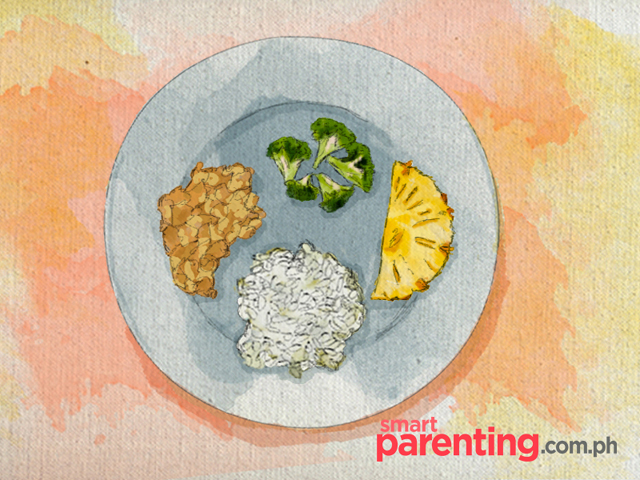-
Parents know how stressful it can be to feed your family healthy food. With all the things we do on a daily basis, it’s sometimes tempting to get take-outs as it’s easier and faster. But while prepping healthy meals for kids sound like a lot of work, it’s doable and you can even get your child to help out!
How to make healthy meals for kids
Nutritious food is essential for kids who are still in their early stages of development. To motivate them, parents need to become good role models and adopt a healthier lifestyle themselves. This starts with the food we eat.
Kids are naturally curious, so they’ll be immediately interested once you show them you enjoy your vegetables as much as you love munching on your chicken. Make yummy noises as you have your mango slice for dessert, and they would want to try it out, too.
Introducing Pinggang Pinoy
Pinggang Pinoy is a tool developed by the Food and Nutrition Research Institute (FNRI) of the Department of Science and Technology (DOST) in collaboration with World Health Organization (WHO), Department of Health (DOH), and National Nutrition Council (NNC).
This tool was created so that Filipino families have an idea how much of each food group should be consumed in every meal. They have visual guides for different age groups, which caters to the different energy and nutritional needs of each group.
They have meal plans for kids 3 to 12 years old, teens 13 to 18 years old, adults, and senior citizens, as well as a separate tool for pregnant and lactating women. You can read more about this helpful tool at the official website of FNRI.
ADVERTISEMENT – CONTINUE READING BELOWHealthy food plate of a Filipino child
 ILLUSTRATOR Boizei Malicdem
ILLUSTRATOR Boizei MalicdemAccording to the Pinggang Pinoy, a healthy food plate of a Filipino child aged 3 to 5 years should have adequate portions of their much-needed go (carbohydrates), grow (protein), and glow (fruits and vegetables) needs. This is based on a 1,300 calorie diet.
- Carbohydrates: 1/2 cup of rice equivalent to 2 small pandesal; 2 slices of small loaf bread; 1/2 cup of cooked noodles; 1/2 medium piece of root crop
- Protein: 1/2 serving or around 15 grams of lean meat (chicken, pork, or beef) or around 1/2 slice of a large fish (like bangus); 1/2 piece of small size, medium variety fish (like galunggong); 1/2 piece of a small chicken egg; or 1/2 piece of tokwa
- Vegetables: 1/2 cup of cooked vegetables
- Fruit: 1/2 to 1 medium sized fruit (like a banana) or 1/2 to 1 slice of a big fruit (like pineapple or papaya)
- Liquids: 5 or more glasses of water a day and 1 glass of milk daily
CONTINUE READING BELOWRecommended VideosRecipes for picky eaters
Once you are more comfortable making meals on your own, try these simple recipes made by dad Eric Corpuz for his son. Previously a picky eater, his son now loves vegetables and can even eat ampalaya!
Vegetables in oyster sauce
Ingredients
- Kale, spinach, kangkong or kamote tops
- Chopped garlic
- Chopped onions
- Olive oil
- Water
- Salt and pepper
- Fried minced garlic, for garnish
Instructions
- Sauté garlic in olive oil.
- Add the leaves and stir-fry in high heat.
- Add oyster sauce (amount will depend on how much green vegetables you’re cooking). Stir fry until leaves are wilted. You may add a bit of water so that the oyster sauce isn’t too thick.
- Add salt and pepper to taste. Garnish with fried minced garlic and serve.
Note: Take it easy on the garlic, and factor in your child’s preference.
Kale fried rice
Ingredients
- Organic brown rice, cooked
- Minced kale
- Minced garlic
- Salt
1. Sauté garlic in olive oil.
2. Add the cooked brown rice.
3. Add in the minced kale, and stir until greens are wilted.
4. Add a dash of salt. Stir and serve.Banana power smoothie
Ingredients
- Two ripe bananas
- Other fruits in stock — it can be apples, avocadoes, oranges, melons, strawberries, pineapple, etc
- 1 bottle of Yakult
- Honey (optional)
Instructions
Mix all ingredients in a blender and blend until smooth (rough, tiny bits might make your child refuse it), and serve.
Note: Leftover smoothie can be frozen as popsicles. You can also reblend it frozen so it will have the consistency of a sherbet or ice cream, which you can then serve as an afternoon snack.
ADVERTISEMENT – CONTINUE READING BELOWWhat about toddlers who struggle to finish their plate according to the recommendations? Registered dietitian, Jennifer Anderson, MSPH, RDN, came up with her version of “toddler portion sizes,” which ranges from “disgusted” to “curious” to “growing.” Take a look below:
If they dislike or refuse to eat a certain vegetable or fruit, you can still put a “disgusted” serving on their plate, equivalent to ½ tsp, shares the mom. There’s also a serving size for sensory play, for those food that they want to explore but won’t eat.
If they’re curious about the taste, the curious serving is equivalent to 2 and ½ Tbs. If it makes them constipated, a serving of ½ Tbs is enough.
Click here for healthy lunch ideas for your child perfect for online classes!
These Hacks Make Sure You’re Prepping Healthy Meals For Your Kids Every Time
Source: Progress Pinas

0 Comments